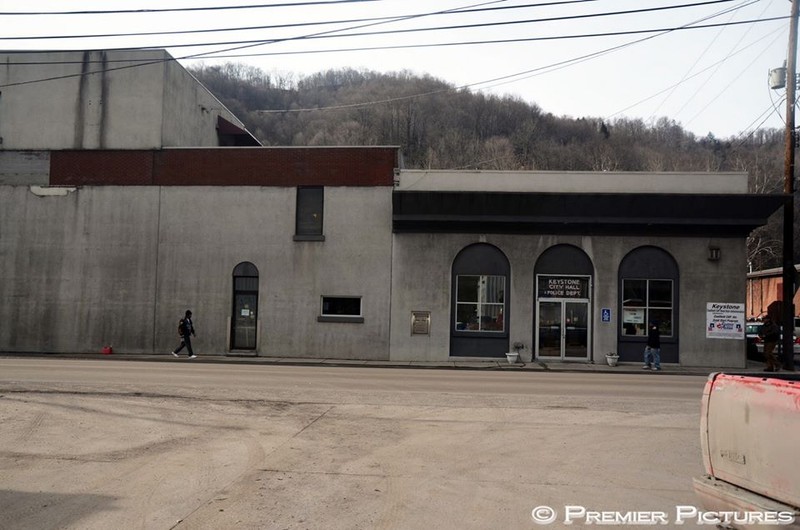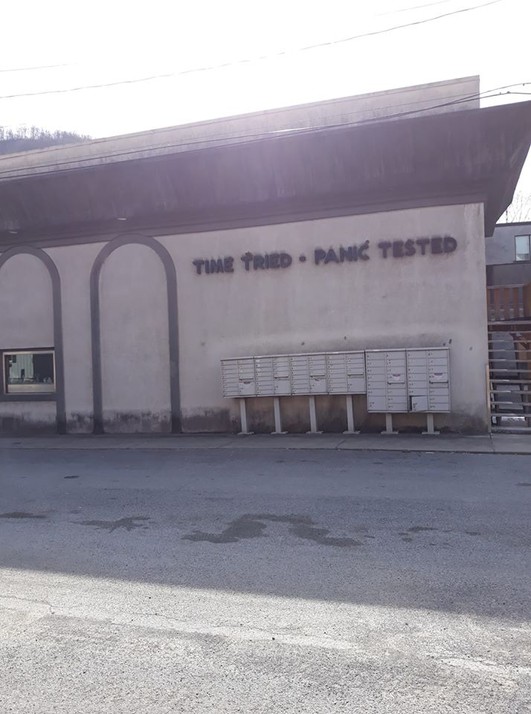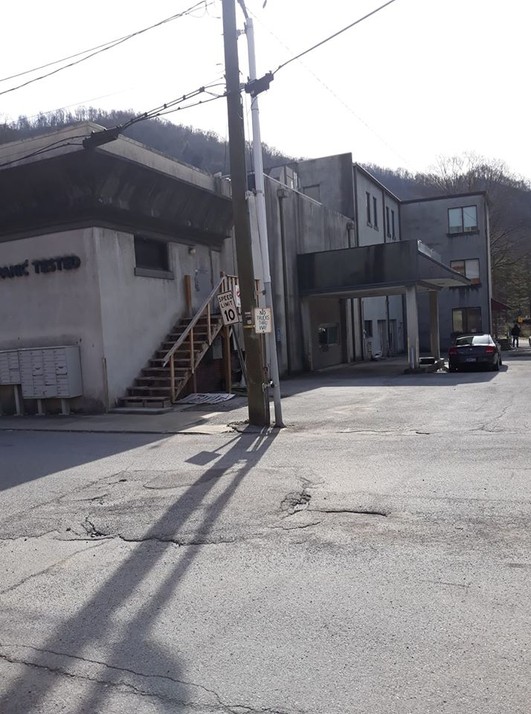The First National Bank of Keystone Scandal
Introduction
Text-to-speech Audio
Images
The First National Bank of Keystone building - now the Keystone City Hall

The Bank in 1981 or earlier - well before the 1996 renovation

The Bank building (now the City Hall) in 2020 - note the bank's motto on the side of the building

The back of the Bank building (now the City Hall) in 2020

Backstory and Context
Text-to-speech Audio
Keystone, McDowell County, West Virginia, was a coal town, established by a mining company in 1892. The city was known as a haven of debauchery and reckless living in its early years; just outside the city was the infamous “Dead Man’s Cut” - notorious for its murders and hold-ups - on the Norfolk & Western Railroad. Its bank, The First National Bank of Keystone, was established in 1904 and was a federal charter bank. This allowed it to issue national bank notes under its name, which it did until 1935. These notes were issued for up to 90% of the value of federal bonds owned by the bank and kept in the U.S. Treasury.
As coal business started to decline in the 1980s, a new financial hope appeared in the community in the form of the growing First National Bank. Pittsburgh banker J. Knox McConnell began expanding the bank into a national institution in 1977. By the early 1990s, as McConnell essentially turned leadership over to his subordinates, Terry Church and Billie Cherry (he would die in 1997), the bank’s business began to skyrocket. The newspaper American Banker called it, “the most profitable community bank in the country.”[3]
The bank’s prosperity came from low overhead – a rural location and only a few dozen employees – and risky home-equity loans. The bank offered these high-risk, high-interest mortgages across the country, then securitized the debt and sold it to investors. This essentially transferred the loans to the investors, who profited off of the interest paid by the original borrower, while the bank, which now had more liquid assets (cash), could safely make and earn interest on more loans. Such deals kept the bank’s risk theoretically low and its profit margins extraordinary – more than double what others banks were gaining. Its assets climbed over $1.1 billion in 1998, the year after McConnell’s death. Church – Keystone Mortgage Company president – and Cherry – bank chairman and city mayor – seemed untouchable.
However, the Office of the Comptroller of the Currency (OCC), America’s bank regulatory agency, began looking at the bank’s records with increased scrutiny. In 1999, the OCC discovered what seemed to be a $515 million discrepancy in the bank’s books. They approached the board with the problem at the end of August; Church and Cherry were caught speechless. The OCC summarily closed the bank and it was taken over by the Federal Deposit Insurance Corporation (FDIC).
Dozens of federal officials poured into the town and discovered a “bewildering” amount of documents stashed in the bank’s recently-renovated rooms and throughout the town.[8] Three truckloads of records had even been moved from an old schoolhouse to a trench on Church’s property, where they were buried. Regulators deduced that the bank, faced with a market downturn, was forced to liquidate the $515 million in mortgages for a much lower cash value and simply did not record the deal, as it could bankrupt the institution. Further investigation uncovered money laundering - somehow connected to an Alabama bingo hall – and other illegal behavior. For example, a codicil to McConnell’s will was found that bequeathed his $19 million fortune to Cherry, instead of his alma mater, and proved to be fraudulent. A complex of national and local lawsuits were spawned in the aftermath of the scandal; while the FDIC payed out over $750 million, many accounts were not insured and clients across the country lost money. In the end, Church, Cherry, Michael Graham (a bank attorney whose CPA license has been revoked earlier), and four others were jailed. Church was the last to be released, in 2015; Cherry had died in prison in 2006.
However, the worst suffering may have been inflicted on the town and people of Keystone. Cherry and Church and her husband owned a document storage company, a hardware store, a large storage building full of Harley-Davidson motorcycles, and the only hotel - a bed and breakfast. The town’s tax revenue went from $600,000 to $200,000 a year. The economic problems spiraled; now, the town only receives $8,000 a year and has serious problems trying to pay for electricity and water service and repairs. The former bank is now the city hall; however, it is still emblazoned with the bank’s motto: “Time Tried – Panic Tested.”
Sources
1) Archer, Bill. Last officer from FNB of Keystone collapse released from prison, Bluefield Daily Telegraph. September 22nd 2015. Accessed February 15th 2020. https://www.bdtonline.com/news/last-officer-from-fnb-of-keystone-collapse-released-from-prison/article_72453348-60da-11e5-9dc3-cbc1c801225a.html.
2) Blake, Linda. The Incredible Story behind the Collapse of the National Bank of Keystone, West Virginia University Libraries. September 4th 2019. Accessed February 15th 2020. https://news.lib.wvu.edu/2019/09/04/the-incredible-story-behind-the-collapse-of-the-national-bank-of-keystone/.
3) Coyne, Caity. After 20 years, former FDIC agents return to Keystone and its people, Charleston Gazette-Mail. September 28th 2019. Accessed February 15th 2020. https://www.wvgazettemail.com/news/southern_west_virginia/after-years-former-fdic-agents-return-to-keystone-and-its/article_a5411d78-ace7-5d2c-a722-1c3f5bd1e17f.html.
4) Coyne, Caity. Once a booming town, Keystone struggles to hold on, Charleston Gazette-Mail. February 18th 2018. Accessed February 15th 2020. https://www.wvgazettemail.com/news/once-a-booming-town-keystone-struggles-to-hold-on/article_fc44b588-61be-5e11-a6cf-04262135dd21.html.
5) DellaMea, Christopher. Keystone, WV; Pocahontas Coalfield; Southern WV; Home, Coalfields of the Appalachian Mountains. Accessed February 15th 2020. http://www.coalcampusa.com/sowv/flattop/keystone/keystone.htm.
6) FDIC Approves Assumption of Insure Local Deposits of First National Bank of Keystone, Keystone, West Virginia - PR-52-99 (9-03-99); Press Releases; News & Events; Home, FDIC. September 3rd 1999. Accessed February 15th 2020. https://www.fdic.gov/news/news/press/1999/pr9952.html.
7) The First National Bank of Keystone, US Bank Locations. Accessed February 15th 2020. https://www.usbanklocations.com/the-first-national-bank-of-keystone-6771.shtml.
8) O'Hara, Terence. W.Va. Hamlet Stunned by Bank Scandal, Washington Post. October 19th 1999. Accessed February 15th 2020. https://www.washingtonpost.com/wp-srv/WPcap/1999-10/19/073r-101999-idx.html?fbclid=IwAR1g1mEU3WXWDPRXcyn1j3N7g5TGjBprh-cvHzAxVtEtwgdH14V0mKol-jk.
9) Old Money from The First National Bank Of Keystone (10369); West Virginia; National Banks; Home, Antique Money. Accessed February 15th 2020. http://www.antiquemoney.com/national-bank-notes/west-virginia/old-money-from-the-first-national-bank-of-keystone-10369/.\
10) Pasley, Robert S.. Anatomy of a Banking Scandal: The Keystone Bank Failure - Harbinger of the 2008 Financial Crisis. New York, New York. Routledge, 2017. Google Books. https://books.google.com/books/about/Anatomy_of_a_Banking_Scandal.html?id=nzYrDwAAQBAJ.
11) What are National Bank Notes?, APMEX. Accessed February 15th 2020. https://www.apmex.com/education/history/what-are-national-bank-notes.
Courtesy of Alan "Cathead" Johnston
Courtesy of Jim Preece
Courtesy of Susan Figgatt
Courtesy of Susan Figgatt
